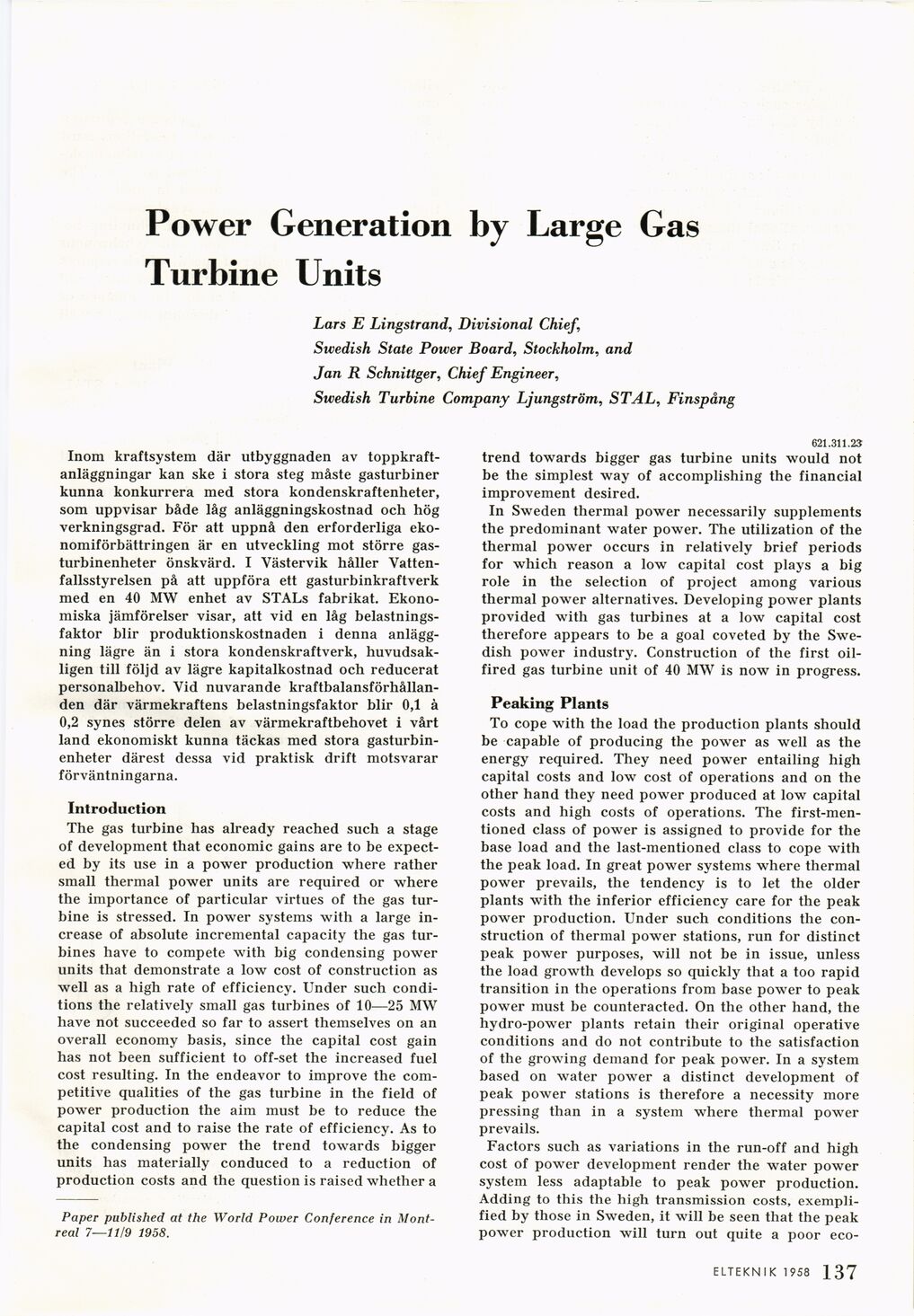
Full resolution (JPEG) - On this page / på denna sida - 1958, H. 10 - Power Generation by Large Gas Turbine Units, by Lars E Lingstrand and Jan R Schnittger

<< prev. page << föreg. sida << >> nästa sida >> next page >>
Below is the raw OCR text
from the above scanned image.
Do you see an error? Proofread the page now!
Här nedan syns maskintolkade texten från faksimilbilden ovan.
Ser du något fel? Korrekturläs sidan nu!
This page has never been proofread. / Denna sida har aldrig korrekturlästs.
Power Generation by Large Gas
Turbine Units
Lars E Lingstrand, Divisional Chief,
Swedish State Power Board, Stockholm, and
Jan R Schnittger, Chief Engineer,
Swedish Turbine Company Ljungström, STAL, Finspång
Inom kraftsystem där utbyggnaden av
toppkraftanläggningar kan ske i stora steg måste gasturbiner
kunna konkurrera med stora kondenskraftenheter,
som uppvisar både låg anläggningskostnad och hög
verkningsgrad. För att uppnå den erforderliga
ekonomiförbättringen är en utveckling mot större
gasturbinenheter önskvärd. I Västervik håller
Vattenfallsstyrelsen på att uppföra ett gasturbinkraftverk
med en 40 MW enhet av STALs fabrikat.
Ekonomiska jämförelser visar, att vid en låg
belastningsfaktor blir produktionskostnaden i denna
anläggning lägre än i stora kondenskraftverk,
huvudsakligen till följd av lägre kapitalkostnad och reducerat
personalbehov. Vid nuvarande
kraftbalansförhållan-den där värmekraftens belastningsfaktor blir 0,1 à
0,2 synes större delen av värmekraftbehovet i vårt
land ekonomiskt kunna täckas med stora
gasturbinenheter därest dessa vid praktisk drift motsvarar
förväntningarna.
Introduction
The gas turbine has already reached such a stage
of development that economic gains are to be
expected by its use in a power production where rather
small thermal power units are required or where
the importance of particular virtues of the gas
turbine is stressed. In power systems with a large
increase of absolute incremental capacity the gas
turbines have to compete with big condensing power
units that demonstrate a low cost of construction as
well as a high rate of efficiency. Under such
conditions the relatively small gas turbines of 10—25 MW
have not succeeded so far to assert themselves on an
overall economy basis, since the capital cost gain
has not been sufficient to off-set the increased fuel
cost resulting. In the endeavor to improve the
competitive qualities of the gas turbine in the field of
power production the aim must be to reduce the
capital cost and to raise the rate of efficiency. As to
the condensing power the trend towards bigger
units has materially conduced to a reduction of
production costs and the question is raised whether a
Paper published at the World Power Conference in
Montreal 7—11/9 1958.
621.311.23
trend towards bigger gas turbine units would not
be the simplest way of accomplishing the financial
improvement desired.
In Sweden thermal power necessarily supplements
the predominant water power. The utilization of the
thermal power occurs in relatively brief periods
for which reason a low capital cost plays a big
role in the selection of project among various
thermal power alternatives. Developing power plants
provided with gas turbines at a low capital cost
therefore appears to be a goal coveted by the
Swedish power industry. Construction of the first
oil-fired gas turbine unit of 40 MW is now in progress.
Peaking Plants
To cope with the load the production plants should
be capable of producing the power as well as the
energy required. They need power entailing high
capital costs and low cost of operations and on the
other hand they need power produced at low capital
costs and high costs of operations. The
first-mentioned class of power is assigned to provide for the
base load and the last-mentioned class to cope with
the peak load. In great power systems where thermal
power prevails, the tendency is to let the older
plants with the inferior efficiency care for the peak
power production. Under such conditions the
construction of thermal power stations, run for distinct
peak power purposes, will not be in issue, unless
the load growth develops so quickly that a too rapid
transition in the operations from base power to peak
power must be counteracted. On the other hand, the
hydro-power plants retain their original operative
conditions and do not contribute to the satisfaction
of the growing demand for peak power. In a system
based on water power a distinct development of
peak power stations is therefore a necessity more
pressing than in a system where thermal power
prevails.
Factors such as variations in the run-off and high
cost of power development render the water power
system less adaptable to peak power production.
Adding to this the high transmission costs,
exemplified by those in Sweden, it will be seen that the peak
power production will turn out quite a poor eco-
ELTEKN I K 1958 ] 47
<< prev. page << föreg. sida << >> nästa sida >> next page >>